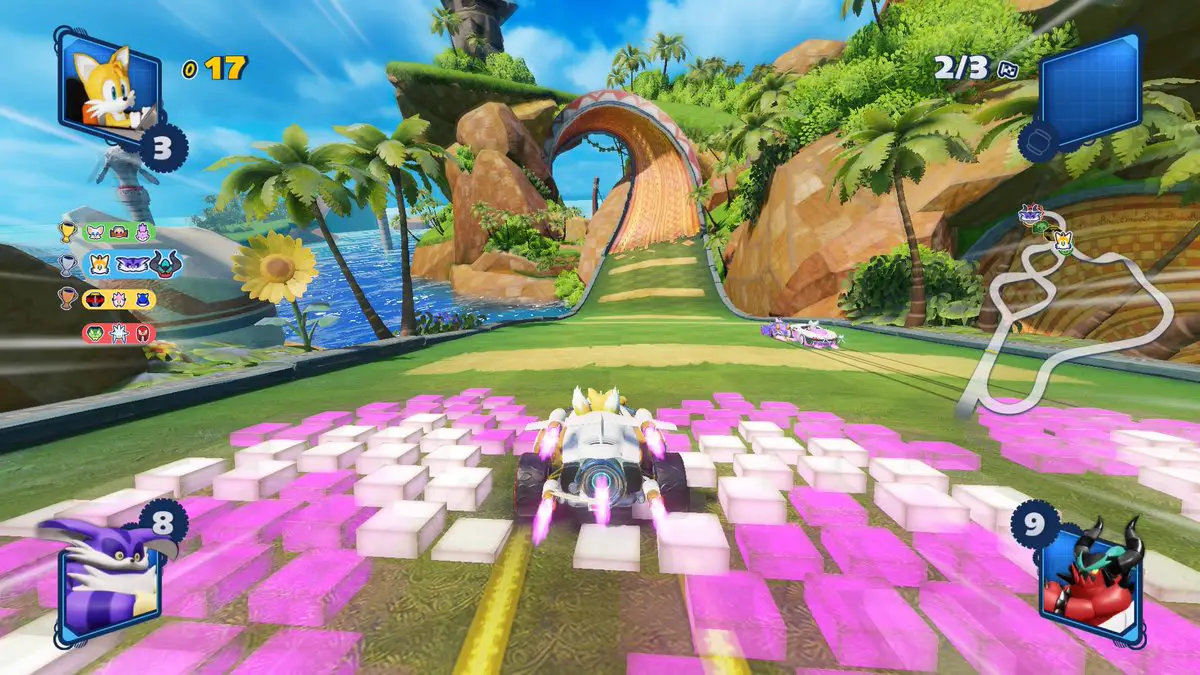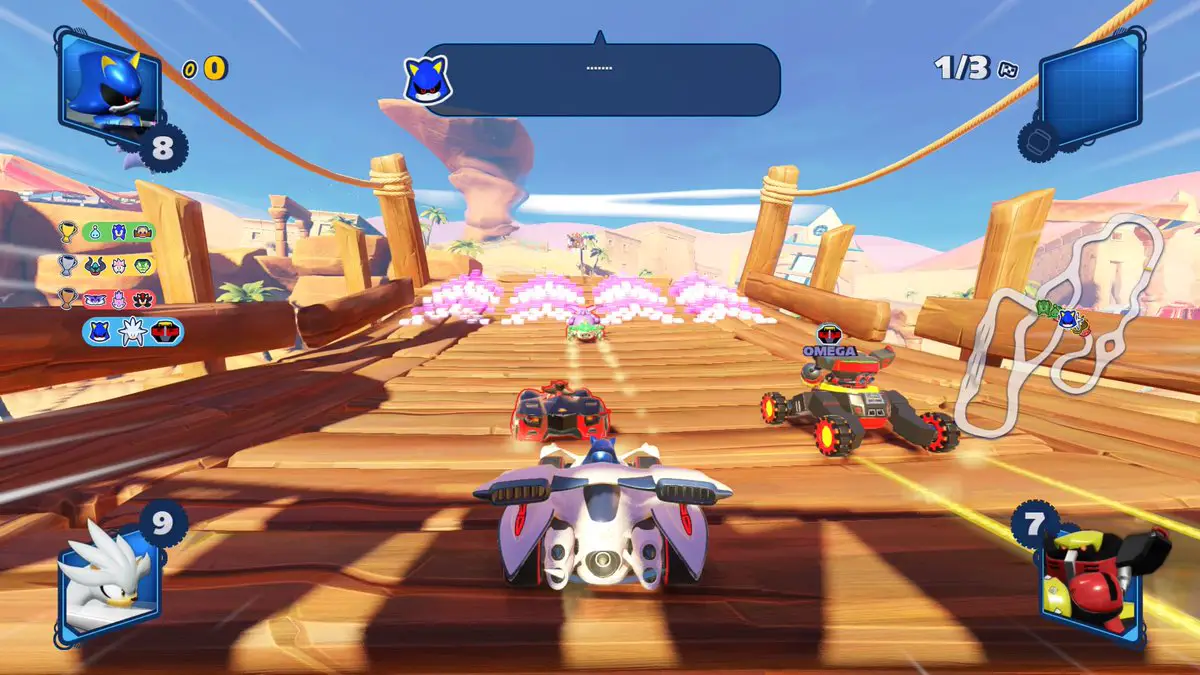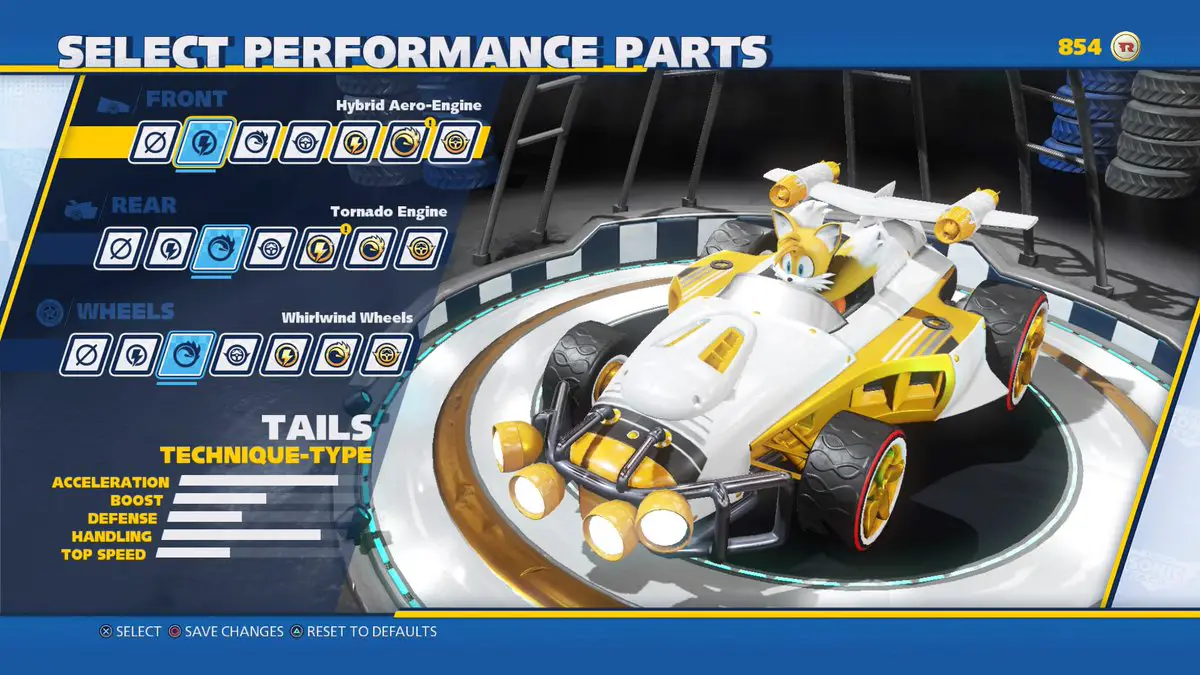
Sonic the Hedgehog has largely, and unfairly, had to live in Mario’s shadow. From their fourth-generation rivalry to their myriad Olympic competitions, the two have always been pitted against each other by not only Sega and Nintendo, but the fans alike. And, largely, the advantage is given to the plumber. It seems that he’s always a step ahead: a sentiment I felt acutely as Sonic jumped into the kart racing genre with Sonic & All-Stars Racing. I simply viewed the title as a lesser Mario Kart, and when its sequel, Transformed, released years later only to be beaten to the punch by Mario Kart 7, I once more wrote the franchise off. However, Team Sonic Racing intrigued me from the beginning. Miraculously, it seemed that Sega and developer Sumo Digital had done something truly new with the kart racing formula—a feat I didn’t think was possible from this series. And now, having sunk serious time into Team Sonic Racing, I can report that the game, while lacking in certain regards, is by and large a well-assembled and fresh kart racer.
What sets this title apart from the past titles and Mario Kart alike is the focus on teamwork—something that may seem initially antithetical to competitive kart racing. I felt that way at first, as it seemed like little more than a riff on Mario Kart’s own underbaked team mode. However, as I began to play more of Team Sonic Racing and understand its nuances, I quickly fell in step with the game’s team-based mechanics. The game’s roster is split into teams of three characters, each with a Speed, Technique, and Power racer. As the race unfolds, you’ll interface with your teammates to work together and win the most total points, accrued based on placement, as one would expect.

There are two core ways to assist each other as you race, and participating in both will fill up your team’s super meter which provides all three racers with temporary invincibility and a massive jolt of speed. The aforementioned methods of working together center around driving together and cooperatively using items. When you drive in the slipstream of a teammate (or they drive in yours), you build up energy and when you slide out of the slipstream, you gain a massive boost—thusly encouraging players to stay close, weaving in and out of each other’s paths. Likewise, if a nearby teammate gets spun out, making contact with them will transfer some of your speed to them, bringing the downed racer back into contention. The other method of teamwork, cooperatively using items, boils down to simply transferring an item from yourself to another teammate. When you do, the item is shuffled, and some items can only be gotten from a teammate’s shared and shuffled item. This is a far more passive approach to teamwork, but it is invaluable when a fellow racer is lagging behind and needs to be brought up to speed.
To that effect, though, while the AI assistants are largely successful in sticking within a few places of your current position, I did experience many times when the AI lagged far behind me, and simply sharing an item wasn’t enough to bring everyone back together. It would’ve been nice to have more passive ways to interact with your teammates in order to keep your ducks in a row. One possible mechanic would be a voluntary reduction of current speed in exchange for a commensurate increase in a teammate’s speed allowing them to close the distance, but putting yourself at a disadvantage. The teamwork aspects all feel rather risk-free, and the introduction of such a feature would’ve made the racing even more dynamic and thoughtful than the core mechanics already are.
Squabbles aside, the central focus on teamwork is undoubtedly the greatest strength of Team Sonic Racing. I found myself genuinely engaged and focused on two levels—not only to ensure that I was performing as well as possible personally, but that I was also doing everything in my power to not only prop my team up, but scout for and sabotage rival teams. While I often fall into a sort of trance when playing a title such as Mario Kart 8 Deluxe, merely focusing on the road in front of me and tuning everything else out, Team Sonic Racing requires constant attention to surmount the competition in the ebb and flow of the race. Having to juggle your personal performance with that of the team’s as well as the proximity of rival teams invigorates the fundamental aspects of Team Sonic Racing’s design which, while solid, act merely as a stage for the teamwork mechanics of racing as they do little of their own to stand out.

If you were to remove the cooperative aspects of Team Sonic Racing, a feat possible here through the optional Standard mode, you would have a totally competent racer—but not much more. The vehicles handle well enough and Sonic’s trademark speed in conjunction with the game’s clever use of blur give the perception that you’re cruising at speeds closer to that of F-Zero than Mario Kart. The karts could’ve felt a bit more tactile, though, as I never felt fully connected to the road nor did I experience totally adequate feedback when hitting a particularly large drift-boost. The somewhat lacking visceral nature of the karts is compensated for by the overarching, electric sense of speed though. The items, represented in this game through modern Sonic’s trademark Wisps, are like the kart handling, totally fine. While none of the items felt especially clever, they all got the job done. The only aspect of Team Sonic Racing’s core formula that is truly lacking, in my opinion, are the tracks themselves.
While visually interesting, the twenty-one tracks on display here all run together. Considering the speed of the game, there isn’t much time to admire the impressive scope and detail of the environments—in the moment all you’re thinking about is the track as it relates to gameplay. Unfortunately, levels don’t feel very distinct in this regard, rarely featuring dynamic set-piece or gimmick sections to make each track feel unique. And, without the ability to cruise the seas and skies through vehicle transformations here in Team Sonic Racing, the tracks feel decidedly one note. They’re all wide, largely vapid tracks. While many successfully play with the idea of alternate paths and split roads, this too is undercut by the game’s breakneck speed, which can often cause to you come upon shoulders or doorways too quickly, slamming into them and getting spun backwards due to a homogenization of level geometry and truncated reaction time. It’s a shame—but it is important to realize that the tracks themselves aren’t bad, they’re just not very memorable.

Beyond the foundation of Team Sonic Racing, the game offers myriad ways to play—including a single-player campaign. While the narrative itself is not particularly engaging, the gameplay itself more than compensates for the blasé storytelling. In addition to the standard team races, this mode offers several alternate types of challenges which keep the experience fresh. From score-based stunt driving to action-oriented Robotnik-bashing, these challenges infused a feeling of variety into the kart racing formula which I haven’t experienced since Mario Kart DS’s Mission Mode. While the campaign overall could’ve used some tightening up as it feels just a few stages too long, overall it was a refreshing addition to the package.
Past the single-player, Team Sonic Racing offers a fairly standard batch of modes including offline Grand Prix and Time Trial races as well as online Team and Standard races. The online play offers more replayability than local play considering the myriad online playlists bring with them different modifiers and a ranking system. However, during my time with the online, I did experience several disconnects and the other reviewers I played with experienced the same problems. That said, the netcode is far from unplayable, but it certainly isn’t all that stable, either. If these issues are assuaged upon launch, the online could be a positive for the title overall, but as it stands it feels more net neutral and no more or less compelling than the local multiplayer.
This is perhaps the most disappointing aspect of Team Sonic Racing, as outside of the single player, the depth of content is lacking. Past jumping into races with friends or the occasional Grand Prix against the AI, there isn’t much incentive to return to the game. There aren’t any creative bonus modes to play around in nor is there any meaningful system of unlocks or progression as all the characters and courses are unlocked through the single-player adventure. Furthermore, the game lacks the sort of filtering and customization present in Mario Kart’s versus mode which forces players to take part in races, largely, how the developers want you to. There isn’t room to adjust items or create a playlist of courses and design decisions such as this truncate Team Sonic Racing’s long-term appeal.

The game does have a very robust customization system—allowing you to swap parts, decals, and color schemes modularly on each racer’s ride—which does provide some reason to keep coming back, but it is tied to an RNG capsule machine which spits out a single, random part at the price of ten credits, earned through regular gameplay. While credits are easy to stockpile, the process of trying to unlock pieces for a particular character is incredibly tedious. You’ll be forced to spam X as you open capsule after capsule hoping for something that’s compatible with your racer of choice. Unlike Mario Kart’s customization, vehicle pieces aren’t universal—so you may end up blowing countless credits unlocking parts for characters you simply have no intention of playing. That said, I was very impressed by the number of granular changes you can make to the karts, down to changing the material of individual pieces of the vehicle, but the hoops you have to jump through in order to utilize this system fully hamper the experience overall.
As such, Team Sonic Racing is a fun yet lacking kart racer. The core teamwork mechanic adds a dynamic feel to the racing which kept me perpetually on my toes and the single-player campaign posited some really clever ideas. I enjoyed my time with Team Sonic Racing as I sped through Sonic’s world and customized my favorite characters. However, my time with the game was cut short by a lack of content and a meaningful system of unlocks. The basic nature of the gameplay when the teamwork aspect is removed, combined with the underwhelming stage selection does the game’s replayability no favors either. There is undeniably a lot of fun to be had with Team Sonic Racing and I can recommend the game confidently. It isn’t everything that I hoped it would be, but it is a fresh, fun take on the kart racing formula that got me to put down Mario Kart—if only for a little while.
Team Sonic Racing
Good
Team Sonic Racing is a fun and intelligently designed, albeit content-light, kart racer. The game’s central focus on teamwork gives the experience a unique and engaging flavor and its sense of speed kept me dialed in. But, that isn’t enough to assuage the title’s evident flaws. From an unimpressive roster of stages to lacking modes outside of Team Sonic Racing’s great single-player campaign, I’d be hard pressed to see this game lasting more than a dozen hours for many fans. While the fundamentals are fun, this racer could’ve used a tune-up before coming to market.
Pros
- Fresh, teamwork-focused approach to kart racing
- Deep customization system
- Robust single-player campaign
- Blistering sense of speed
Cons
- Underbaked array of courses
- Content-light side modes
- Unsatisfying progression system
